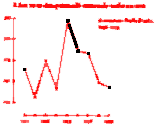 |
Level of Measurement Refresher |
|
|
|
|
|
Just in case you need a refresher on the
different levels of measurement, the below three paragraphs are taken
directly from Social Statistics for a Diverse Society [2000], by
Frankfort-Nachmias and Leon-Guerrero, pg 13-14. [Note this text combines
interval level and ratio level variables into one category -
interval-ratio, this module follows that example] |
|
|
|
| Nominal Level of
Measurement At the nominal level of measurement, numbers
or other symbols are assigned to a set of categories for the purpose of
naming, labeling, or classifying the observations. Gender is an
example of a nominal level variable. Using the numbers 1 and 2, for
instance, we can classify our observations into the categories
"females" and "males," with 1 representing females and
2 representing males. We could use any of a variety of symbols to
represent the different categories of a nominal variable; however, when
numbers are used to represent the different categories, we do not imply
anything about the magnitude or quantitative difference between the
categories. |
|
|
|
| Ordinal Level of
Measurement Whenever we assign numbers to rank-ordered
categories ranging from low to high, we have an ordinal level
variable. Social class is an example of an ordinal variable. We
might classify individuals with respect to their social class status as
"upper class", "middle class", or "working
class". We can say that a person in the category "upper
class" has a higher class position than a person in a "middle
class" category, but we do not know the magnitude of the differences
between the categories; that is, we don't know how much higher "upper
class" is compared to "middle class". |
|
|
| Interval/Ratio Level of
Measurement If the categories (or values) of a variable can be
rank-ordered, and if the measurements for all the cases are expressed in
the same units, then an interval-ratio level of measurement has
been achieved. Examples of variables measured at the interval-ratio level
are age, income, and SAT scores. With all these
variables we can compare values not only in terms of which is larger or
smaller, but also in terms of how much larger or smaller one is compared
with another. In some discussions of levels of measurement you will see a
distinction made between interval-ratio variables that have a natural zero
point (where zero means the absence of the property) and those variables
that have zero as an arbitrary point. For example, weight and length have
a natural zero point, whereas temperature has an arbitrary zero point.
Variables with a natural zero point are also called ratio variables.
In statistical practice, however, ratio variables are subjected to
operations that threat them as interval and ignore their ratio properties.
Therefore, no distinction between these two types is made in this text. |
|
|
|
|
|
|
|
